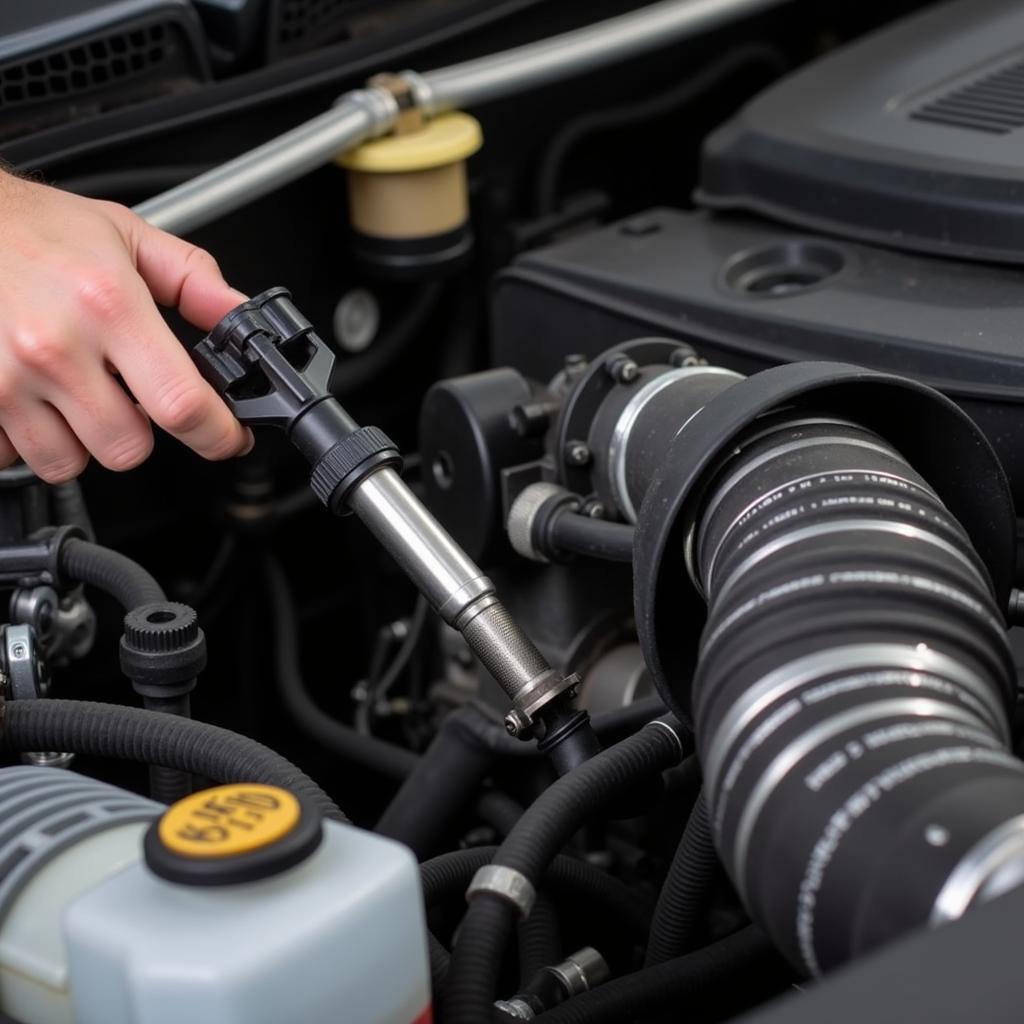A vacuum leak can wreak havoc on your car’s performance, causing a rough idle, reduced fuel efficiency, and even engine damage. Knowing how much to fix a vacuum leak is crucial for budgeting and avoiding unnecessary expenses. This article will delve into the costs associated with vacuum leak repairs, the factors that influence pricing, and how to potentially diagnose the issue yourself.
Understanding the cost to fix a vacuum leak requires examining several factors. The severity of the leak, the location of the leak, and your car’s make and model all play a role in the final price. A simple hose replacement can be relatively inexpensive, while a cracked intake manifold can be significantly more costly. Let’s break down these factors in more detail.
Identifying the Culprit: Locating the Vacuum Leak
Locating the vacuum leak is the first step towards fixing it. Some common culprits include cracked or disconnected vacuum hoses, faulty intake manifold gaskets, and issues with the throttle body. A visual inspection is often the starting point. Look for any loose, cracked, or disconnected hoses.
 Checking Vacuum Hoses in a Car Engine
Checking Vacuum Hoses in a Car Engine
How Much Does a Vacuum Hose Replacement Cost?
Replacing a vacuum hose is typically the least expensive fix, often ranging from $50 to $200, including parts and labor. If you’re handy with tools, you can often replace a vacuum hose yourself for the cost of the part, which is usually under $10. You might find resources helpful on engine fixes my summer car.
Dealing with Intake Manifold Gasket Leaks
A faulty intake manifold gasket can be a more serious and expensive issue. The intake manifold gasket seals the gap between the intake manifold and the engine block, preventing air leaks. Replacing this gasket requires more labor and specialized tools, and the cost can range from $200 to $600 or more, depending on the complexity of your car’s engine.
What are the Symptoms of a Leaky Intake Manifold Gasket?
A leaky intake manifold gasket can cause a rough idle, hissing sounds from the engine, decreased fuel economy, and even engine misfires. If you suspect this is the issue, it’s essential to have it diagnosed and repaired by a qualified mechanic. You might want to read more about how to fix a misfire on a car.
Throttle Body Troubles and Vacuum Leaks
The throttle body controls the amount of air entering the engine. Problems with the throttle body itself or its associated components can also cause vacuum leaks. Repairing or replacing the throttle body can cost anywhere from $150 to $500, depending on the specific issue and your car’s make and model. Sometimes, simply cleaning the throttle body can resolve the issue, which is a much less expensive fix.
“A vacuum leak, no matter how small, can lead to a cascade of problems. Addressing it promptly can save you money and headaches in the long run.” – John Miller, Certified Automotive Technician
“Don’t underestimate the importance of regular maintenance. Catching a vacuum leak early can prevent more costly repairs down the line.” – Susan Davis, Automotive Engineer
Conclusion: Fixing Your Car’s Vacuum Leak
Knowing how much to fix a vacuum leak on your car empowers you to make informed decisions and avoid overpaying for repairs. While a simple hose replacement might only cost a few dollars, more complex issues like a faulty intake manifold gasket can require a larger investment. Remember, early diagnosis is key to minimizing costs and keeping your car running smoothly. Contact AutoTipPro at +1 (641) 206-8880 or visit our office at 500 N St Mary’s St, San Antonio, TX 78205, United States for expert advice and assistance. Don’t let a vacuum leak drain your wallet and your car’s performance. If you’ve had a busted window, you might find this article on fix busted car window helpful. Gamers interested in car fixes might want to check out san andreas fix car cheat. Or if you have a classic car, this article on car running too rich fix 67 camaro could be useful.
FAQ
-
What does a vacuum leak sound like? A vacuum leak often sounds like a hissing or whistling noise coming from the engine.
-
Can I drive my car with a vacuum leak? While you might be able to drive short distances, a vacuum leak can cause significant damage over time. It’s best to have it repaired as soon as possible.
-
How do I find a vacuum leak in my car? You can visually inspect the vacuum hoses and listen for hissing sounds. Using a smoke machine or carb cleaner can also help pinpoint the leak.
-
How much does it cost to fix a vacuum leak at a mechanic? The cost can range from $50 to $600 or more, depending on the location and severity of the leak.
-
Can I fix a vacuum leak myself? Replacing a vacuum hose is a relatively simple DIY repair. However, more complex issues should be handled by a qualified mechanic.
-
What are the symptoms of a vacuum leak? Symptoms can include a rough idle, decreased fuel efficiency, hissing sounds, and engine misfires.
-
How can I prevent vacuum leaks? Regular maintenance and inspections can help prevent vacuum leaks. Inspecting your vacuum hoses periodically and replacing them when they show signs of wear can help avoid future problems.






Leave a Reply